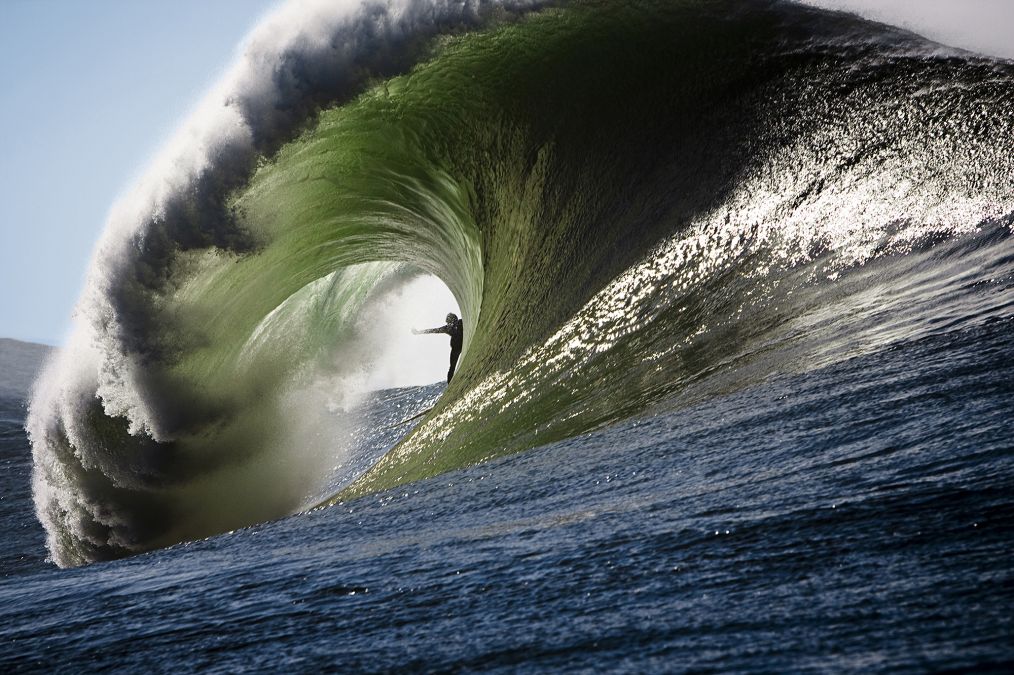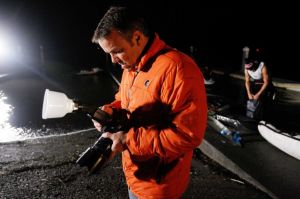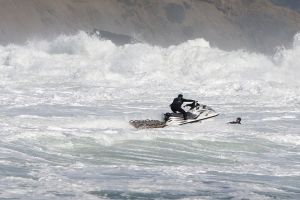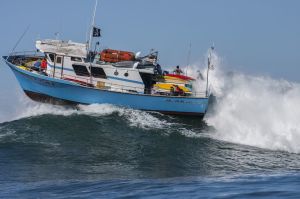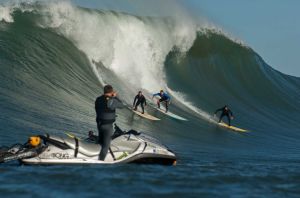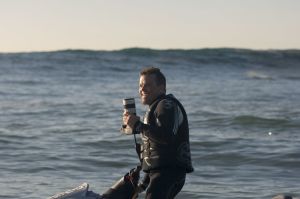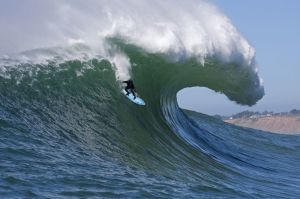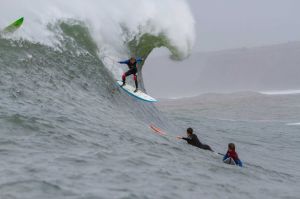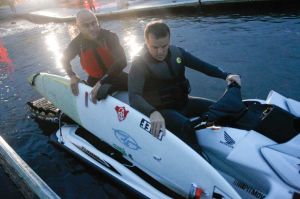VIA SF – CHRONICLE
January 1, 2015 Updated: January 1, 2015 5:15pm
Quirarte, who uses personal watercraft to get close to big-wave surfers, checks an image on the beach in Half Moon Bay last month.
By the looks of him, Greg Long was dead. One of the world’s greatest big-wave surfers was floating face-down after a terrible wipeout that held him under water for more than a minute. To compound the horror, the scene was Cortes Bank, a fabled and seldom-ridden shoal some 100 miles off the coast of San Diego.
After a huge wipeout, Using his personal watercraft, Frank Quirarte pulls Kohl Christenson to safety out at Mavericks. Image by Fred Pompermayer
Before embarking on his journey, Long made meticulous safety plans. There were certain people he needed if a worst-case scenario unfolded. One of them was Frank Quirarte, the Pacifica photographer known for his heroic rescue missions both in and out of the ocean. And there was Quirarte, one of three Jet Ski drivers racing to the scene of Long’s catastrophe through a narrow gap between waves.
“There’s no way to describe what goes on at Cortes,” Quirarte said. “It’s not like any other surf spot. You’re way out to sea, giant waves are breaking in two different spots, so you can’t get close enough to really see who’s doing what. We just knew Greg was down.
“When we got to him, his face … it wasn’t even purple. It was starting to turn black,” Quirarte recalled. “It shocked me for a split second. My friend is dead! But no — we’re gonna save him. No one’s dyin’ out here.”
Quirarte captured this photo of the 40-foot charter boat Huli Cat getting hit by a Mavericks wave and almost capsizing during the filming of “Chasing Mavericks” in 2012.
Frank Quirarte stands on a watercraft to shoot images from the channel at Mavericks. It puts him in a good position if he is called on to rescue surfers.
The three men dragged Long’s lifeless body onto a rescue sled, furiously performing resuscitation en route to the crew’s main boat, where paramedics administered oxygen. He began to show signs of life. Eventually, Long was taken by helicopter to a San Diego hospital, there to make a slow but complete recovery.
‘He’s right there’
What kind of man signs up for this? Quirarte, 51, is a man who routinely powers his Jet Ski into raging cauldrons of whitewater to rescue fallen surfers at Mavericks, often with a giant wave bearing down on them. A man who doesn’t merely hear about Hurricane Katrina and its devastation of the New Orleans landscape, but boards a plane to become part of the rescue crew.
Frank Quirarte out at Mavericks. Image by Doug Acton
“It’s almost like he’s most comfortable in situations like that,” said San Francisco surfer Grant Washburn, who has witnessed many of Quirarte’s rescues at Mavericks. “He’s a photographer by trade, getting great shots out there, but when somebody goes down, he’s committed to that. Everybody’s freaking out, most guys (on watercraft) driving away, but no problem for Frank, he’s right in there. When a guy like Greg Long says he wants Frank out there spotting him, that tells you everything.”
Quirarte’s late father, of Spanish-Mexican descent, was a machinist who attended San Francisco’s Mission High School and was “a real stand-up guy,” Frank said. “I’m the youngest of four boys, and they all went into the military, so I figured that was my destiny. I wasn’t much of a student, but I scored very high on the mechanical portion of the aptitude test, so I went into the Air Force and wound up in aircraft maintenance.”
Fascinated with Mavericks
He became so proficient that, upon his discharge, he became a mechanic for Delta Airlines in San Francisco, and when the Gulf War broke out in 1990, he was called out of his reserve unit to serve in Operation Desert Storm. “I worked on C-141s, C-5s, the big ones,” he said. “I wound up being reactivated for 2½ years. Back with Delta, I was pretty resigned to being an airline mechanic. Great money, great travel, but it started to wear on me. I knew I didn’t want to turn wrenches for the rest of my life.”
A lifelong Pacifica surfer, with a thirst for waves of consequence, Quirarte became fascinated with Mavericks’ burgeoning popularity in the mid-1990s. He was watching from the cliff in 1994 when a weeklong swell changed the face of California big-wave surfing and took the life of Hawaii’s Mark Foo. “It’s hard to explain, but something came over me during that swell,” he said. “Like something was calling me to be part of this.”
Quirarte had always been an expert Jet Ski driver, from the days of his youth on Lake Oroville (his parents had a houseboat there) to a stint as course marshal for a nationwide Jet Ski racing tour. “I started bugging (Mavericks pioneer) Jeff Clark about getting out there with a camera, because you needed Jeff’s blessing,” he said. “He finally let me try. I got some great advice from Larry Moore, Don Montgomery, Doug Acton, Vern Fisher, the photographers who regularly shot Mavericks. When the first contest came around (1999), I was part of the water patrol. And it just sort of took off from there.”
Quirarte’s close-range surfing photos are some of the most stunning ever shot, anywhere in the world. Mavericks surfers find comfort in the notion that he will be on the scene, if at all possible, if they’re confronted with a near-death brand of wipeout. No witness will ever forget the time Quirarte, stuck in mid-rescue because his craft stalled in the foam, got mowed down by a violent avalanche of onrushing whitewater. He was pushed all the way to the bottom, took “forever” to fight his way to the surface, and was perilously close to the inside rocks when Clark arrived on his own Jet Ski to pull him out. (Undaunted, with his craft unharmed, Quirarte went right back out for more.)
South African Grant “Twiggy” Baker flies over a massive ledge at Mavericks during the filming of Chasing Mavericks. 2012 Image by Frank Quirarte
New Orleans ordeal
His trip to post-Katrina New Orleans in 2005 was an entirely new adventure.
He was sitting at home watching the television coverage when he heard from Bill Sharp, a lifelong surfer, adventurer and head of the annual XXL Big Wave Awards. The idea was to fly into Houston, drive to the disaster site, obtain watercraft (with government clearance) and negotiate the steamy rivers of hell, looking to help anyone in need.
“I’ve known a bunch of people who talk a good game,” said Sharp, who joined the relief effort in Sumatra after the 2004 tsunami. “And when the s— goes down, they’re not there. Frank is just rock-solid, no matter what environment he’s in. He gets into an emergency situation, and he has that calm under pressure.”
Santa Barbara Surfer Matt Becker gets completely airborne on a wave at Mavericks. Image by Frank Quirarte
Motoring down the deeply flooded streets, Quirarte experienced a nightmare: dead bodies, abandoned animals, an eerie silence occasionally broken by a cry for help. One woman, an apparent suicide victim, was pinned grotesquely to a railing. “It was insanely hot,” he said. “We broke into this one house we had to check out, and it had to be 120 degrees in the crawl space. That’s where people were hanging out — older people, emaciated, dehydrated, sick … so brutal. We were there a week, until the water started to recede. One day we managed to get 20 people onto some aluminum boats that were floating around and towed ’em out. That was pretty rewarding.”
Danger of disease
In that setting, the potential for disease was overwhelming. “We were waterproofed from head to toe, but at the end of each day we took a bleach shower,” he said. “Clothes off, just pouring these gallon jugs of water and bleach all over us, killing everything. At least I think it worked.”
Would he do it again?
“Oh, yeah,” he said. “I’d hope I wouldn’t have to, but if need be — yeah.”
I asked Quirarte what moves a man to do these things, where such bravado might come from. He grew silent for a spell. “I couldn’t even tell you,” he said. “It’s just there. We were always doing crazy things as kids — jumping off trees, motocross, Jet Skis — stuff that was right out there on the edge. When you’re the baby, and you’ve got three brothers into all that stuff, you just try to keep up.
“Without my wife’s support, I couldn’t have done it,” he said (they have four children, all from previous marriages). She gets what I’m doing, knows not to even get near me when I’m in the middle of something. Can’t sleep at night, super excited, super scared, curious about what the next adventure is going to bring. Whatever it may be, it’s never lost its excitement. And she’s always there for me. Helps me keep the dream alive.”
Bruce Jenkins is a San Francisco Chronicle columnist. E-mail: [email protected]
For the original source go here:
 Become A Sponsor!
Become A Sponsor!If you have a product or service that is a good fit for our surf community, we have opportunities for you to sponsor this blog! Download our media kit now!

